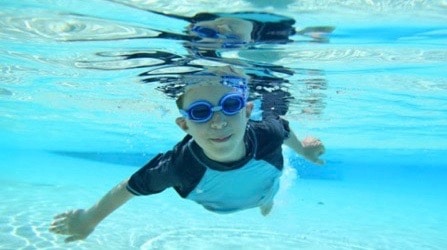“ By the end of the first session, Johnny trusted Ian so completely that he was floating on his back, his body completely relaxed.”
As a critic, it’s useful to travel with a companion who knows his own mind. This time, however, I had a feeling my son’s attitude could prove an obstacle: “I don’t want to go. I hate swimming. And if you make me, I just won’t get in the pool. At all.”
Based in west Wales, where the Pembrokeshire Coast National Park meets Cardigan Bay, Swimming Without Stress runs residential courses with a twist. The two luxury holiday cottage companies with which the group works both have private, indoor heated pools. Book in for a break at either and Ian Cross or his wife, Cheryl, will visit you daily for one-on-one swimming tuition, using an “intensive, but sensitive” method incorporating the posture-improving Alexander Technique.
Swimming, Ian told me, should be “like yoga in the water, an almost meditative experience, as good for the mind as it is for the body.” As a confident swimmer for whom the pool is a place to unwind, I couldn’t disagree. But I wasn’t so sure that a five-year-old, pool-phobic non-swimmer would see it the same way.
Ian, however, was confident that his approach would help Johnny. And so we headed to Wales, arriving late at night in the pitch dark. Opening the door to the Dairy, one of 10 properties on this rural site outside Cardigan, we found fresh cakes waiting on the table for the children and locally made mead for the adults. The place had all the relevant equipment for children, ample space for muddy boots, and an open-plan living space with a wood-burning stove and deep, comfy chairs.
At 9.30 the next morning, Andy, the owner, was ready to tour the farm with the children, feeding the goats, pigs, sheep, rabbits and guinea pigs. Splashing through the mud, the kids took in the football pitch, the mini adventure playground and the play barn, with air hockey and table tennis for teenagers and, for smaller children, play vehicles, slides and a sand pit.
Another thing revealed in the morning light was the pool complex. A tiny sprint across the gravel drive from our cottage, it was spotlessly clean and warm. There was a sauna, a small gym and a mini soft-play area. At 30ft, the pool is long enough for more accomplished swimmers to work on their strokes, while the shallow end is 3ft deep, ideal for small children.
When Ian suggested that I too might benefit from lessons, I signed up, aware that seeing me practise might help persuade Johnny. Sure enough, after watching my first half-hour session, he forgot his pledge and waded happily into the shallow end.
From the moment we learn to swim, Ian explained, most of us take gasping breaths and kick wildly to stay afloat. In fact, our first step should be to learn to trust the water and let it support us. If we can allow our heads to sink below the surface, blowing bubbles calmly, we are far less likely to panic.
This was one step too far for Johnny, who refused to submerge his head. Five lessons followed, in which Ian gently encouraged him first to submerge his mouth and blow bubbles, then his nose, too. By the end of the first session, Johnny trusted Ian so completely that he was floating on his back, his body completely relaxed, with just Ian’s hands gently supporting his neck.
In between lessons, we explored the countryside. The location is perfect: just 15 minutes from the jaw-dropping Poppit Sands beach; and the same to the awe-inspiring Cilgerran Castle. St Dogmaels and its cosy pub and restaurant, The Ferry Inn, are also worth a visit. The trouble was, the kids didn’t want to leave the pool – and nor did I, having developed an almost evangelical enthusiasm for swimming.
Breaststroke has always been my best stroke. Ian filmed me doing a length and showed me the footage. My technique looked good, but my neck was frozen as I held my head above the water. To correct this, I practised floating, letting go of all tension and allowing the water to support my body. It felt amazing – restorative, even – to let my head sink as I swam, then, as I raised my head to breathe, let my eyes lead the way so that my head was always in gentle motion.
From the start of our week-long break, Ian emphasised the benefits of learning together, as a family. While our lessons were separate, Johnny and I watched each other and my husband and daughter later joined us in the pool, testing what we’d learnt.
My lessons, like Johnny’s, were about getting back to basics: enjoying the support of the water and doing less. Passing on this ease in the water is one of the most valuable lessons we can give our children. Soon, he said, Johnny would be dunking his head under the water and swimming like a fish.
Sure enough, five minutes after we said goodbye to Ian, Johnny took off his armbands and jumped in. He tunnelled down below the water, then bobbed back up again, his head dripping water and with a huge grin on his face. Mission accomplished.


